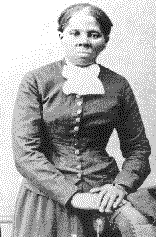| She then
returned, disguised as a man, to get her husband, but found that in her
absence he had taken another wife. She then turned her energies toward
the freeing of other slaves. She became known as “The Moses of Her People”
for her repeated trips into the South to lead slaves north to freedom.
She was extremely clever, making trips mostly in winter when the nights
were longer, and leading slaves away on Saturday nights so they wouldn't
be missed until Monday. In 1857 she brought away her own parents, and,
since they were too feeble to walk, hired a wagon for them. Her last trip
was in 1860, bringing a group North into Canada to avoid the Fugitive Slave
Act, which since 1850 had required escapees found in the Northern U.S.
to be returned to slavery.
Although the
price on her head rose to $40,000, she was never captured, nor did she
ever lose a passenger on her Railroad. She later served as a nurse, scout
and a spy during the Civil War, in North Carolina, South Carolina, Georgia
and Florida. She is said to have been at Fort Wagner, and to have been
the one who fixed breakfast for Colonel R. G. Shaw before he led his African-American
troops into that famous battle. There are several sites in the Bucktown,
Maryland area associated with Harriet, including the plantation, and her
church.
Harriet
bought a home in Auburn, New York, for herself and her parents after the
Civil War, and lived there the rest of her life. She never received any
pension or compensation from the government for her Civil War services,
although she was later awarded a pension as the widow of her second husband,
Nelson Davis. Nursing her own parents, she turned her house here into a
home for the aged. A group of relatives and friends gathered to sing “Swing
Low, Sweet Chariot” upon the evening of her death on March 10, 1913, and
she was buried with full military honors. The Harriet
Tubman Home still stands today, restored to its late 19th century appearance,
and displays her original bedroom furnishings and some personal items,
including a huge family Bible.
Harriet
is buried beneath an enormous tree planted by her family at Fort
Hill Cemetery. On the first anniversary of her death the city of Auburn
declared an unprecendented one-day memorial to Harriet, and in 1978 a postage
stamp was issued to honor her, the first American stamp to ever honor an
African-American woman.
For specific travel information about these sites, check the "Travel
Resources" page.
|
